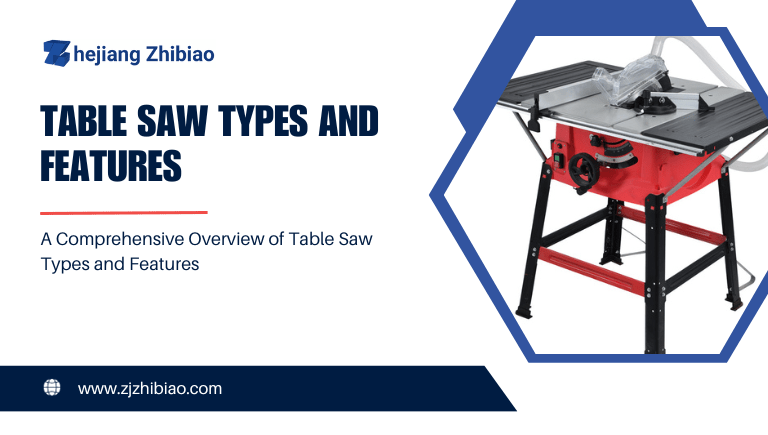Table saws are essential tools for woodworking enthusiasts, contractors, and DIYers alike. They come in various types, each designed to serve specific purposes and featuring unique attributes. In this comprehensive guide, we will explore the world of table saws, discussing the different types available and Table Saw Types and Features. Whether you’re a seasoned woodworker or a beginner looking to invest in the right tool, this article will help you make an informed decision.
Table of Contents
Toggle1. Introduction to Table Saws
What is a Table Saw?
A table saw is a versatile woodworking tool consisting of a circular saw blade mounted on an arbor, powered by an electric motor. This power tool is known for its precision and ability to make clean and accurate cuts in a variety of wood materials.
The Evolution of Table Saws
Table saws have a rich history dating back to the early 19th century. The first iterations were cumbersome and hand-cranked, but advancements in technology have led to the modern, electric-powered table saws we use today. The evolution of these tools has revolutionized the woodworking and construction industries, making tasks faster and more precise.
2. Types of Table Saws
Benchtop Table Saws
Overview and Uses
Benchtop table saws are the smallest and most portable among table saw types. They are designed for jobs where mobility is crucial. These compact saws can be easily placed on a workbench or mounted on a stand, making them ideal for contractors who need a mobile option.
Pros and Cons
Pros:
- Portability: Benchtop saws are lightweight and easy to transport.
- Affordability: They are often more budget-friendly than larger models.
- Suitable for Beginners: Ideal for those new to woodworking.
Cons:
- Limited Power: They may not handle heavy-duty materials as effectively.
- Smaller Rip Capacity: The width of cuts is restricted due to their compact size.
- Less Stability: They may not be as stable as larger models, impacting precision.
Who Should Consider Benchtop Saws?
Benchtop table saws are a great choice for DIYers, hobbyists, and contractors who require mobility for smaller projects.
Contractor Table Saws
Overview and Uses
Contractor table saws are a step up in terms of power and stability. They are larger and offer more robust performance, making them a popular choice among professionals.
Pros and Cons
Pros:
- Good Balance: Contractors get a balance of power and portability.
- Larger Rip Capacity: They can handle wider materials.
- Suitable for Various Projects: Versatile enough for a wide range of tasks.
Cons:
- Less Portable: They are bulkier and less mobile than benchtop models.
- Space Requirement: Contractor saws need a dedicated workspace due to their size.
Who Should Consider Contractor Saws?
Intermediate to advanced woodworkers and contractors who require a reliable and versatile table saw.
Cabinet Table Saws
Overview and Uses
Cabinet table saws are the epitome of power and precision in the world of table saws. They are heavy-duty machines designed for demanding woodworking projects.
Pros and Cons
Pros:
- High Power: Cabinet saws boast exceptional motor power.
- Large Work Surface: They provide ample space for larger workpieces.
- Excellent Stability: These saws are incredibly stable and precise.
Cons:
- Heavy and Immobile: They are large and not easily transportable.
- Expensive: Cabinet saws come at a premium price due to their capabilities.
Who Should Consider Cabinet Saws?
Experienced woodworkers and professionals who demand precision and durability in their projects.
Hybrid Table Saws
Overview and Uses
Hybrid table saws blend the features of contractor and cabinet saws, offering a balance of power and portability.
Pros and Cons
Pros:
- Adequate Power: They provide enough power for various tasks.
- Reasonably Portable: Hybrid saws strike a balance between size and mobility.
- Versatile: Suitable for a wide range of woodworking projects.
Cons:
- Not as Powerful as Cabinet Saws: They may not handle extremely heavy-duty tasks as efficiently.
- Less Portable than Contractor Saws: Hybrid saws are bulkier than benchtop models.
Who Should Consider Hybrid Saws?
Woodworkers who want a versatile saw with a balance of power and portability for their projects.
3. Key Features to Consider
Motor Power Explained
How Motor Power Affects Performance
Motor power is a crucial factor in a table saw’s performance. A higher-powered motor allows the saw to effortlessly cut through thicker and harder materials, making it ideal for demanding woodworking tasks.
Matching Motor Power to Your Needs
When choosing a table saw, assess your typical projects and select a saw with a motor power rating that aligns with your requirements. This ensures that your cuts are efficient and precise.
Blade Size and Types
The Importance of Blade Size
The size of the saw blade significantly impacts the depth and width of cuts. Larger blades are suitable for cutting thicker materials, while smaller blades excel at finer, intricate work.
Different Types of Saw Blades
Saw blades come in various types, each designed for specific materials and cutting purposes. Understanding the right blade for your project ensures clean and accurate cuts.
Fence and Rip Capacity
Why a Good Fence is Crucial
A high-quality fence is essential for making straight and accurate cuts. It provides stability and prevents the material from shifting during the cut, resulting in precise results.
Understanding Rip Capacity
Rip capacity refers to the maximum width of material a saw can cut. It’s vital to match the rip capacity to your project requirements, ensuring that you can work with larger workpieces when needed.
Safety Features
Blade Guards and Splitters
Blade guards and splitters are essential safety features that protect users from accidental contact with the spinning blade. They should always be used as intended to prevent accidents.
Riving Knives
Riving knives are critical for preventing kickback, a potentially dangerous situation where the material gets pinched by the blade. They help maintain a safe cutting environment.
Anti-Kickback Pawls
Anti-kickback pawls further enhance safety by preventing the material from moving backward during a cut. These features are crucial for preventing injuries in the workshop.
12. Choosing the Right Table Saw for Your Needs
Assessing Your Woodworking Projects
Consider the type and scale of woodworking projects you frequently undertake. Your choice of table saw should align with your specific requirements to ensure efficiency and precision in your work.
Budget Considerations
Set a budget based on your woodworking needs and choose a table saw that offers the best value within your price range. Remember that investing in a quality saw can pay off in terms of durability and performance.
13. Maintenance Tips for Longevity
Cleaning and Lubricating
Regularly cleaning and lubricating your table saw’s components, such as the blade and moving parts, is essential to prevent wear and tear. A well-maintained saw will continue to perform optimally.
Blade Replacement
Replace the saw blade as needed to maintain cutting precision and safety. A sharp blade not only produces cleaner cuts but also reduces the risk of accidents.
14. Conclusion
In conclusion, a table saw is an indispensable tool for woodworking enthusiasts and professionals alike. Understanding the different types of table saws and their key features is essential for making an informed purchase decision. Whether you opt for a portable benchtop saw, a versatile contractor saw, a heavy-duty cabinet saw, or a balanced hybrid saw, your choice will significantly impact the quality of your woodworking projects.
15. Frequently Asked Questions (FAQs)
Q1: Can I use a benchtop table saw for professional woodworking?
A1: While benchtop table saws are more suitable for light to medium-duty tasks, some professionals use them for their portability. However, for heavy-duty and precision work, contractor or cabinet saws are recommended.
Q2: What is the ideal rip capacity for a table saw?
A2: The ideal rip capacity depends on the size of the materials you work with. For general woodworking, a rip capacity of 24 inches or more is recommended.
Q3: Are safety features like blade guards necessary?
A3: Yes, safety features like blade guards are crucial for preventing accidents and ensuring user safety when using a table saw. Always use them as intended.
Q4: Can I upgrade my table saw’s motor?
A4: Some table saws allow for motor upgrades, but it’s essential to check the manufacturer’s specifications and guidelines before attempting an upgrade.
Q5: What’s the difference between a cabinet table saw and a hybrid table saw?
A5: Cabinet table saws are heavier, more powerful, and designed for professional use. Hybrid table saws offer a balance of power and portability, making them suitable for a wider range of woodworking enthusiasts.






